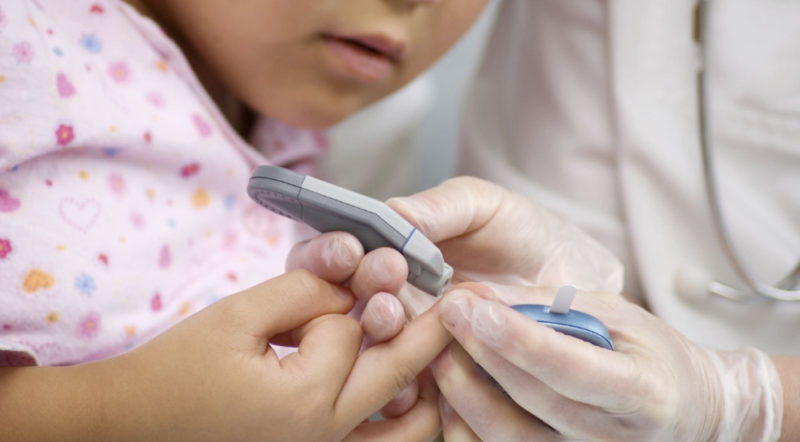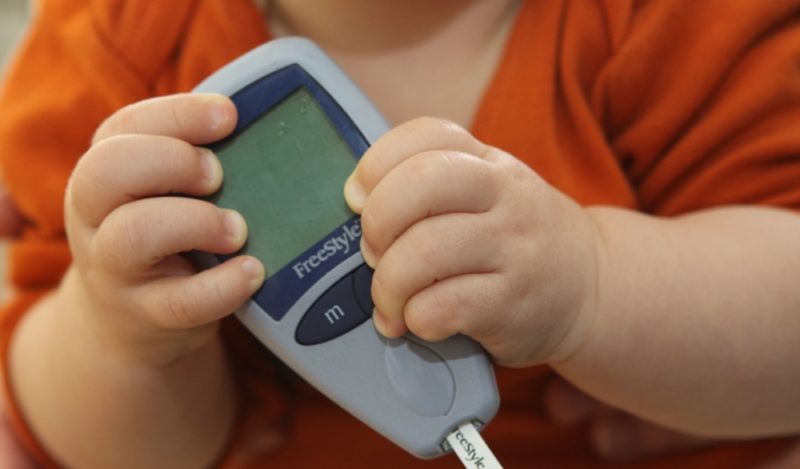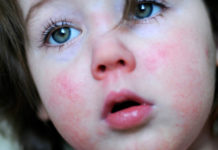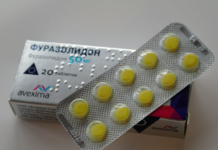The course of many diseases differs in the symptoms and characteristics of the treatment of patients of different ages. What is the danger of diabetes in children? And what are the treatments for this pathology?
Material Content:
What is diabetes
Diabetes mellitus is an endocrine disease accompanied by malfunctions of the body's metabolic processes. Often, the disease is marked by a decrease in cellular responses to insulin and a violation of its production.
Allocate type 1 and type 2 diabetes. The first type is also called insulin-dependent diabetes. It is monitored in small patients in 80 - 90% of cases. Type 2 diabetes is characterized as non-insulin dependent. Children are exposed to it much less frequently - in 10 - 20% of cases.
Note. Of all endocrine disorders, diabetes is most often detected in young patients.
Causes of pathology in children
The following causes of diabetes are distinguished:
- Heredity. Diabetes is inherited with a 80% probability if one parent is affected by the disease. When both parents are sick, the pathology will appear in the child with a probability of 100%.
- Overeating, a large number of fast carbohydrates on the menu. Impaired carbohydrate metabolism reaches its maximum by about 5 years. Already during this period, modern children do eat the so-called “adult” foods with might and main.Given the fact that the functionality of the pancreas is fully launched only at the age of 6, this organ experiences a constant load when consuming baked goods, sweets, and other carbohydrate-containing foods. Characteristically, in the future, this method of nutrition provokes cellular depletion and obesity.
- Viral diseases. Rubella, mumps and viral hepatitis have an effect on the pancreas. When a child has a predisposition to diabetes, these pathologies can enhance the manifestation of endocrine disease.
Additional factors in the development of pathology include hypodynamia, which causes obesity, and SARS.
Symptoms and signs of an illness of type 1 and 2
Symptoms of diabetes in children vary and are determined by the type of ailment and the age of the small patient.
Type 1 diabetes
Toddlers up to 12 months old. It is difficult to track the symptoms of diabetes in babies, because the main harbingers of diabetes (an increase in the incidence of urine output, an increase in its quantity, and thirst) are difficult to identify.
The following options for the onset of the disease in babies are distinguished:
- Sudden development. It is noted by vomiting, rapid loss of fluid, intoxication, and, as a result, coma.
- Gradual development. The child does not gain weight for no apparent reason, even with excellent appetite. The baby is often restless and calms down only after receiving a drink. Diaper rash may not heal for a long time.
Children aged 1 to 5 years. The onset of the disease is more severe and acute. The child has a syndrome of impaired absorption: the patient’s stomach increases in size, growth and weight gain are delayed.
Additional symptoms include:
- decrease in blood glucose;
- increased acetone in the urine;
- anxiety;
- vomiting when eating sugary foods;
- refusal of food.
Children of school and adolescence.
The symptoms of diabetes at this age are similar to those observed in adults:
- increased urination;
- weight loss;
- "Jamming" in the corners of the mouth.
- thirst;
- deterioration in academic performance;
- increased appetite;
- headache;
- irritability, aggression;
- urinary incontinence;
- dry palms, feet.
Symptoms in children with type 2 diabetes
- visual impairment;
- increased urine output;
- the presence of glucose in the urine;
- weight loss;
- thirst.
Type 2 diabetes mellitus in children is marked by the rapid onset of vascular problems (ischemia, renal failure, atherosclerosis, heart attack).
How is the diagnosis
Diagnosis of diabetes is carried out using a number of studies:
- Blood glucose test. It is carried out on an empty stomach to determine the glucose content in capillary blood.
- Glucose tolerance test. The amount of glucose in the blood is determined 30 to 120 minutes after a patient drinks a glucose solution.
- Detection of C-peptide and insulin in the blood. With type 1 disease, these indicators are significantly higher, while with type 2 disease may be normal.
- Control of glycated hemoglobin (the latter in the blood of patients with diabetes is significantly overestimated).
Note. A patient diagnosed with diabetes must certainly be systematically observed by an endocrinologist.
Endocrine Disease Treatment
Features of the treatment of diabetes mellitus largely depend on the type of disease. So, in children with type 1 diabetes, acute insulin deficiency in the body is monitored. Such a pathology is treated exclusively with insulin injections; any other intervention is ineffective and can endanger the health and even life of a small patient.
The control scheme for this type of disease involves:
- daily insulin injections;
- optimal physical activity;
- dieting.
Type 2 non-insulin-dependent diabetes is treated with the help of complex therapy, including:
- optimal physical activity;
- continuous diet;
- the introduction of hypoglycemic drugs;
- normalization of weight in obesity.
Physical activity should include sports at least 3 times a week for 60 minutes. Also, children are recommended daily walks of 2 - 3 km, adolescents - 4 - 6 km. Additionally, the recommendations of the endocrinologist regarding nutrition should be followed. The combination of these measures is enough to maintain a normal concentration of sugar in the blood of a small patient, as well as his general well-being.
The nutritional guidelines for type 1 and type 2 diabetes are almost identical. The main condition is the restriction or complete rejection of dishes that provoke an excessive load of the pancreas.
The list of prohibited products includes:
- bakery products;
- some cereals (rice, semolina);
- pasta;
- pickles, canned food, smoked meats;
- fatty dishes;
- potatoes;
- industrial juices;
- some fruits (bananas, grapes);
- sweets (chocolate, jam, etc.).
It is permissible to include in the menu:
- vegetables, fruits (except prohibited);
- mushrooms;
- dairy products;
- lean meat, fish;
- seafood;
- herbal tea.
Note. In cases where diabetes mellitus manifested itself quickly and entailed multiple complications, the patient may require emergency injections of insulin.
When the glucose level is stabilized, hormone intake can be stopped and sugar-lowering medication can be taken later. In this case, they recommend the only drug allowed for children - Metformin.
Features of treatment in infants
Diabetes mellitus in infants is not often diagnosed. In total, medical statistics recorded 34 cases of the disease in infants.
Hepatitis in children of this age group is difficult, because dehydration is monitored in infants, and urine and blood sugar levels increase.
The average requirement of the human body for insulin is 1 unit / 1 kg of weight. Chips sensitive to this hormone may also be prescribed antihistamines. Injections of insulin in infants are best combined with long-acting drugs. The latter enhance the therapeutic effect of the injection.
Also, children of the first year of life should adhere to a certain diet, the features of which should be discussed with an endocrinologist and pediatrician. Babies who are breast-fed, breast-fed or mixed-fed are fed according to the general principles of feeding.
Possible complications and consequences
Endocrine pathology can lead to additional negative reactions of the body.
The following possible complications of diabetes in children are distinguished:
- atherosclerosis of blood vessels;
- neuropathy;
- heart attack;
- glaucoma, cataracts;
- stroke;
- hypertension
- itching and peeling of the skin;
- angina pectoris, dermatological pathologies;
- fragility of bones.
Note. The sooner the pathology is detected, the more likely it is to stop possible complications.
The lack of necessary therapy and the late detection of the disease can provoke severe consequences that affect almost all body systems.
Diabetes Prevention in Children
Prevention of diabetes in children occurs taking into account the recommendations:
- Compliance with the daily routine.
- Organization of proper nutrition. The child should eat at least 3 times a day. The menu should include slow carbohydrates, and pastries, sweets, industrial juices, carbonated drinks should be minimized.
- Regular physical activity. It is best if the child will devote time to active outdoor games in the fresh air.
- Increased immunity (intake of vitamins, walks in the fresh air, hardening).
- Stress avoidance.
- Smoking ban. This restriction is especially true for adolescents who may begin to try tobacco products for self-affirmation.
All of these tips are especially relevant for children and adolescents, among whose relatives there are people suffering from diabetes.
Diabetes mellitus is called a violation of the endocrine system of the body.Given the fact that modern diseases are becoming increasingly “younger”, it is not surprising that diabetes is often monitored in children and adolescents. Treatment should be carried out taking into account the form of the disease and the age characteristics of the small patient.

















